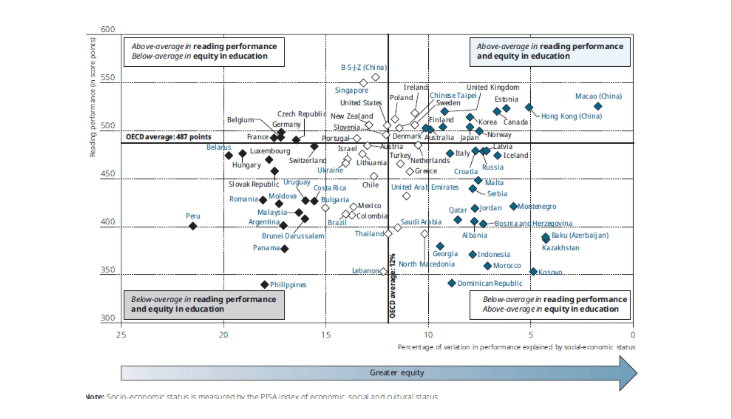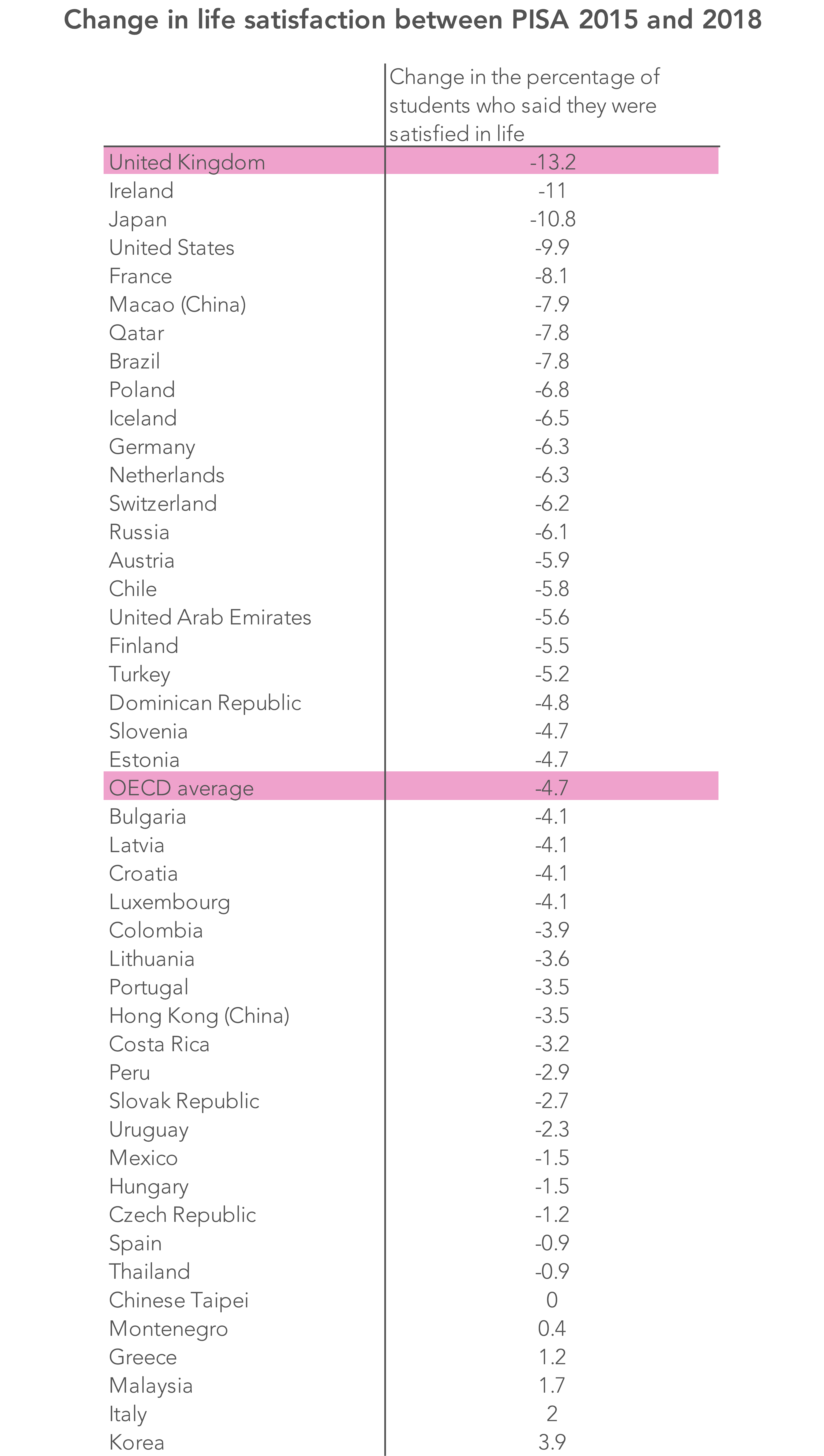Nine key findings from PISA 2018
By Blog Editor, IOE Digital, on 3 December 2019
3 December 2019
By John Jerrim
Results from the PISA 2018 study have just been released. This is the triennial update of how the UK has performed on these closely scrutinised (and highly politicised) tests.
Given that this is election season, and that this is the first set of results since Michael Gove’s GCSE reforms properly took effect, I am expecting to see a lot of discussion about the results.
Some of which will, of course, be more accurate than others.
My job today will be to try and help people see the wood for the trees so we can all properly understand the results.
In this first blogpost, I’ll provide a crash course of what I have taken as some of the more interesting results (after a very quick first look!).
1. The uptick for maths in England will no doubt get all the headlines… but let’s not get carried away!
No doubt this is what will take all the headlines. In PISA 2018, average maths scores for England rose by around 10 points from previous cycles, or around four months of schooling on the OECD’s scale. And, as the chart below shows, this did not happen across the rest of the UK.
But hold your horses before getting too excited. One good set of results is NOT a trend! And a swing of this size in PISA can simply be a result of changes in methodology.
We need to wait until the next PISA results in 2021 before we can start to say anything concrete.

2. The real story is the UK’s long-run decline in science (particularly outside England)…
Actually, to my mind, the more robust and interesting finding is the UK’s long-running decline in PISA science scores.
Although there has been a small fall in England over time, the bigger worry is science performance in Scotland, Wales and Northern Ireland. In these three countries, there has been a sustained fall over the last 12 years.

3. …and particularly the decline in the science scores of the highest achievers
And, as the chart below shows, it is the science scores of the highest achieving pupils in the UK that seem to be in the greatest decline.

Again, there has been a fall in England, where the score needed to get into the top 10% of PISA science performers has dropped from 653 in 2006 to 635 in 2018. But this is dwarfed by some other parts of the UK, like Scotland and Wales – where there has been a very clear drop in the PISA scores of the top 10% since 2006.
4. For reading, the OECD are describing the UK as performing ‘above average’ and as ‘equitable’…
Going against conventional wisdom, the UK is now “above average” in reading, and with a comparatively narrow socio-economic gap – see the chart below. The UK appears in the top-right hand quadrant which indicates that UK reading scores are above the OECD average, while we also have above average levels of equity.
The relationship between performance and equity in PISA reading scores

Source: OECD PISA 2018 report. Volume II. Page 338.
The OECD also reports that the UK has one of the highest levels of “resilience” (meaning poor kids who perform highly in PISA reading) anywhere in the world: 14%, compared to an OECD average of 11%.
5. ….but “equity” in reading scores looks very different across the four parts of the UK
Equity in educational achievement does however look rather different across the UK. The chart below illustrates how the poorest 25% of children in England, Wales, Northern Ireland and Scotland actually get pretty similar PISA reading scores (around 470 points).
Where the four countries of the UK differ is in the achievement of pupils of high socio-economic status. For young people from affluent backgrounds, England stands out from Scotland, Northern Ireland and (particularly) Wales.

6. Life satisfaction is lower among UK teenagers than other countries…
As the chart below shows, where the UK really does stand out from other countries is life satisfaction: 15-year-olds in the UK are much less likely to say that they are satisfied in life than those in almost every other country that participated in PISA 2018.
Indeed, just 53% of 15-year-olds in the UK are satisfied with their life, compared to 67% across the OECD as a whole.

7. …and life satisfaction has fallen dramatically over the last three years
Now, here is the REALLY big headline. The life satisfaction of 15-year-olds across the UK has fallen faster than in any other country with comparable data over the last three years.
In the UK, the decline in the share of 15-year-olds who rated their life satisfaction as 7 and above on a 0 to 10 scale fell by 13 percentage point. There was also a fall across the OECD as a whole (a decline of around 5 percentage points), but that was much less than the UK’s fall.
Students in the UK were also much less likely to report that they have a sense of meaning in life than their peers in other OECD countries.
We only have two years of data: PISA 2015 and PISA 2018. So again, we need to be cautious when talking about trends, but this may still raise concerns.

8. Is fear of failure driving these low levels of life satisfaction in the UK?
The answer is possibly!
The OECD report notes that there is a correlation between life satisfaction and 15-year-olds having a fear of failing. Moreover, the strength of this relationship is much stronger for the UK than the OECD average.
In fact, the link between fear of failure and life satisfaction is stronger in the UK than almost every other country.
One possible explanation is that, in the UK, young people take the PISA tests in the build-up to high-stakes GCSE exams.
9. UK kids are more likely to say they have a “growth mindset” than kids in other countries
The idea of having a “growth mindset” has become quite trendy in education. This is the idea that abilities are not fixed, but can be changed.
For the first time, PISA 2018 allows us to compare what percentage of teenagers consider themselves to have a growth mindset across countries. They were given the statement “Your intelligence is something about you that you can’t change very much” and asked to rate themselves on this measure.
And, it turns out, the UK does pretty well! Around 70% of 15-year-olds in this country say they have a growth mindset, compared to an OECD average of 63%.
In fact, as the table below illustrates, there are only a few other countries where the percentage of young people with a growth mindset is greater than the UK.
The percentage of 15-year-olds with a “growth mindset”
| Percentage of 15-year-olds describing themselves as having a growth mindset | |
| Estonia | 77 |
| Denmark | 75 |
| Germany | 74 |
| Ireland | 74 |
| Iceland | 73 |
| Latvia | 73 |
| Lithuania | 72 |
| Austria | 72 |
| United Kingdom | 70 |
| United States | 68 |
| Australia | 68 |
| Canada | 68 |
| New Zealand | 67 |
| Japan | 67 |
| Finland | 67 |
| Ukraine | 66 |
| Portugal | 66 |
| Brazil | 63 |
| Switzerland | 63 |
| Sweden | 63 |
| OECD average | 63 |
| Israel | 63 |
| Luxembourg | 62 |
| Spain | 62 |
| Hungary | 62 |
| Colombia | 61 |
| Chile | 60 |
| Russia | 60 |
| Chinese Taipei | 60 |
| Singapore | 60 |
| Turkey | 60 |
| Bulgaria | 59 |
| Italy | 59 |
| Slovak Republic | 57 |
| Croatia | 56 |
| Belgium (Flemish) | 56 |
| B-S-J-Z (China) | 56 |
| Kazakhstan | 55 |
| Belarus | 55 |
| Costa Rica | 54 |
| Malta | 54 |
| Uruguay | 54 |
| France | 54 |
| Korea | 53 |
| Viet Nam | 53 |
| Czech Republic | 52 |
| Serbia | 52 |
| Baku (Azerbaijan) | 52 |
| Peru | 52 |
| Slovenia | 51 |
| Bosnia and Herzegovina | 51 |
| Netherlands | 51 |
| Qatar | 50 |
| Georgia | 50 |
| Argentina | 49 |
| Macao (China) | 49 |
| Greece | 48 |
| Jordan | 47 |
| Brunei Darussalam | 47 |
| United Arab Emirates | 46 |
| Montenegro | 45 |
| Mexico | 45 |
| Moldova | 43 |
| Romania | 43 |
| Saudi Arabia | 43 |
| Thailand | 43 |
| Hong Kong (China) | 43 |
| Morocco | 42 |
| Malaysia | 41 |
| Albania | 41 |
| Poland | 41 |
| Lebanon | 41 |
| Dominican Republic | 35 |
| Philippines | 31 |
| Panama | 29 |
| Indonesia | 29 |
| Kosovo | 28 |
| North Macedonia | 24 |
2 Responses to “Nine key findings from PISA 2018”
- 1
-
2
What do the PISA results tell us about Scottish education? – Professor Mark Priestley wrote on 6 December 2019:

[…] to 2018, but the difference is small, and also may be a one off fluctuation. To quote the recent UCL/IoE blog on the UK PISA […]
 Close
Close




[…] question is timely as the outcomes of the 2018 PISA exercise have just been released. They show once again that England’s scores are fairly stable […]